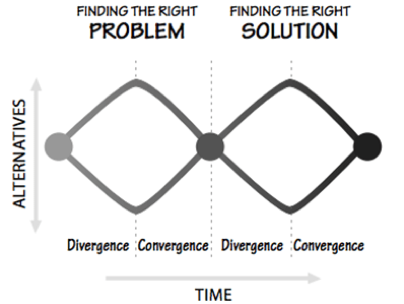“Good designers never start by trying to solve the problem given to them: they start by trying to understand what the real issues are” (Norman, 2013, p. 217). This is accomplished through a process of convergence and divergence using a process of rapid tests of ideas, modifying the approach after each test, and eventual problem definition (Norman, 2013).

Bringing initial ideas to the stakeholders (students) early in the problem definition phase of design is essential. Dr. Clark identifies the difficulties that emerge when designers identify the problem, come up with an idea, iterate on that idea, publish it, invest a great deal of time and effort into that version of the idea, deliver it to the audience (students), and are then disappointed when people don’t understand the brilliance of the idea or don’t like the idea.
Engaging in design thinking involves:
- Identifying the problem and fulfilling human needs
- Which involves:
- Idea generation [also called ideation]
- Feedback [from colleagues and students. Notion of radical collaboration.]
- Collaboration
- Which involves:
- Engaging in prototyping [includes feedback loops and radical collaboration]
- Testing [includes gathering evidence, feedback loops, and radical collaboration]
- Observation [gathering evidence]
- Refinement and back to idea generation [each iteration through the components makes progress.]
Questions for Discussion
- Marlene Scardamalia, professor at the Ontario Institute for Studies in Education, University of Toronto, contends that in design mode all ideas are regarded as improvable. In what ways does getting feedback from students and colleagues engage teachers in improvable idea generation?
- Consider some ways that you might engage students in a process of convergence and divergence using a process of idea improvement through the rapid tests of ideas, modifying the approach after each test, and eventual problem definition.
References
Norman, D. (2013). The design of everyday things. New York, NY: Basic Books.
